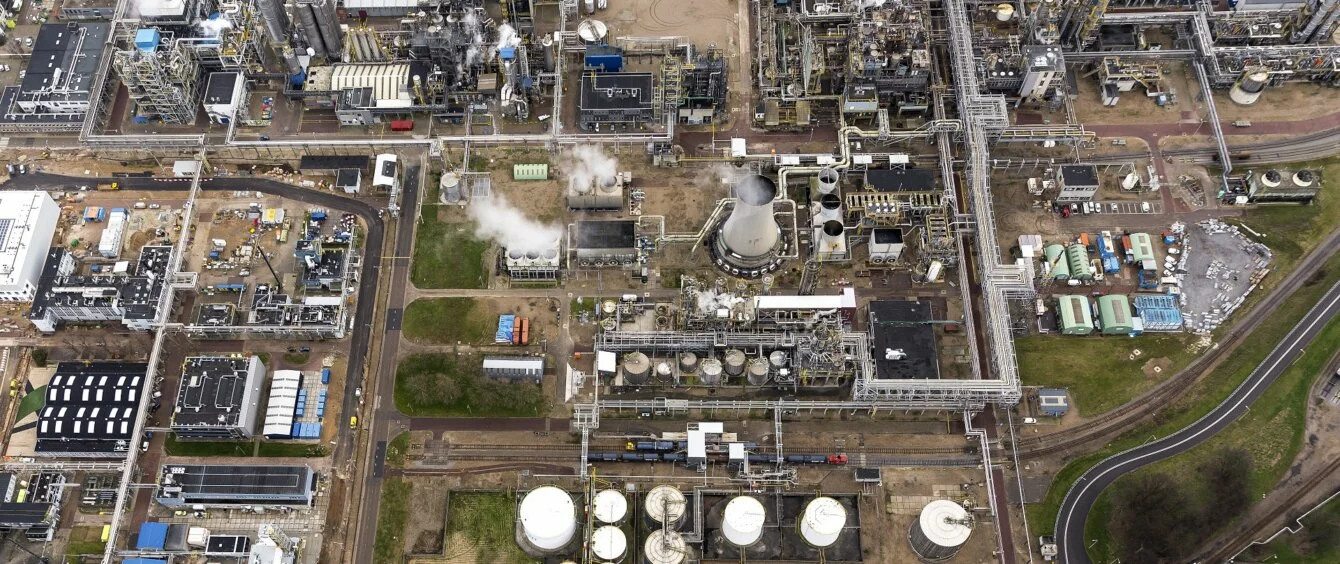
RWE is planning to build a plant of the FUREC (Fuse Reuse Recycle) project at the Chemelot industrial park in Geleen, Limburg, the Netherlands. The plant will recycle municipal waste into hydrogen and make it available to industry at the chemical park.
© Aerovista Luchtfotografie, shutterstock.com
Using household waste is not a new concept when it comes to producing power. According to the German Environment Agency, all of the country’s waste incineration plants use this resource to generate electricity, heat – or both. On average, overall energy efficiency is around 50 percent and these power stations emit around five million metric tons of carbon dioxide annually in the process.
Recycled hydrogen as part of the circular economy
Instead of the waste being burned, it could essentially be fully recycled. This would allow for the raw materials it contains to be reused. In fact, pilot plants of this nature already exist. At first glance, the urban waste at these sites seemingly disappears into thin air through gasification. In actual fact, the vapours are split into different gas mixtures from which – depending on the process – different raw materials can then be recovered.
Similar processes have been around for about 100 years. The difference now is that investors are taking an interest in sourcing hydrogen from waste. No wonder then that the companies helping to build the hydrogen economy are also looking into waste-to-hydrogen cycles.
Today’s hydrogen needs could be met with waste
One of these companies is RWE. The Essen-based energy utility wants to use its FUREC (fuse, reuse, recycle) project to build a plant in the Netherlands that will recycle the urban waste of approximately two million people annually. This would turn 700,000 metric tons of waste into around 54,000 metric tons of hydrogen.
Frequently used as a resource in the chemical industry, hydrogen has long been a sought-after raw material. But now, it is also making headlines as an energy source in the context of the energy transition. So far, however, hydrogen has had to be produced almost entirely using fossil fuel – first and foremost natural gas. But this is set to change, with hydrogen being increasingly produced carbon-neutrally.
Green hydrogen as an energy source can help cut greenhouse gas emissions. In the transport sector in particular, it is seen as a more cost-effective and – above all – more feasible alternative to CCUS technologies, which capture carbon dioxide during production and stop it from entering the atmosphere. In the steel industry, hydrogen can also be used instead of carbon as a reducing agent. In layman’s terms this means replacing carbon dioxide with steam.
Green hydrogen is often seen as unavoidable on the road to decarbonisation. Various studies have forecast that global hydrogen demand will increase exponentially in the next 30 years.
The raw materials produced could be sold to buyers based in the Chemelot industrial park, where RWE is also planning its FUREC plant. Supplying industrial customers in the Ruhr region or Rotterdam is another option, according to RWE. The site is located in the South Limburg region, so not far from the German border near Cologne.
Using circular carbon dioxide
Given that urban waste is largely comprised of organic material, significant volumes of carbon dioxide are an inevitable by-product of producing hydrogen. The plan is to capture the carbon and sell it as a key basic material for the chemical industry. According to the German Ministry of Research (Link in German), the country’s chemical industry uses about 21 million metric tons of carbon dioxide every year, e.g. to produce plastic. About 90 percent currently comes from fossil fuels.
Overall, RWE expects the Chemelot industrial park to be able to reduce its annual natural gas consumption by more than 280 million cubic metres thanks to the FUREC plant. This would be equivalent to half the amount of gas consumed by Limburg’s 1.1 million inhabitants annually. RWE puts the associated CO2 savings at 400,000 metric tons, which – according to the International Energy Agency (IEA) – corresponds to the average per capita emissions of around 50,000 German or Dutch citizens.
European Union supports development
In mid-January 2023, the EU Innovation Fund, financed with proceeds from CO2 certificate trading, pledged €108 million for the FUREC project. All told, RWE believes the budget will exceed €600 million.
Spurred by the funding, the energy company now wants to press ahead and seek the necessary approvals and preliminary contracts with potential plant builders, waste suppliers and customers for the extracted raw materials. A final investment decision is to be made in 2024.
FUREC will help RWE to build on its commitment to developing a hydrogen economy. This is also the aim of its joint venture GetH2, which covers cross-border initiatives for extracting, transporting and using sustainable hydrogen.
Hydrogen from gasification instead of electrolysis?
Until now, green hydrogen has mostly been produced by electrolysis. However, only around three-quarters of the energy used can actually be stored as hydrogen. So large-scale electrolysis will only be environmentally friendly when sufficient renewables are available to meet immediate electricity demand, making it much more efficient.
Waste gasification requires relatively little electricity because much of the energy needed comes from the waste itself. Although the process is not necessarily cheaper when considered in isolation, if one offsets the revenue generated from disposing of the waste, experts believe competitive waste-to-hydrogen solutions could become available in the medium term.